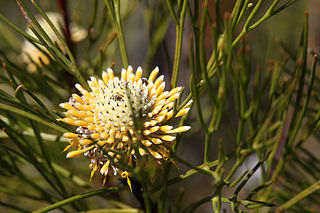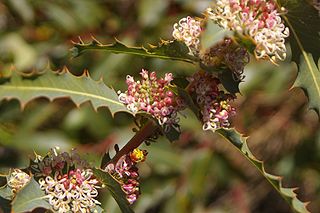
Hakea salicifolia commonly known as the willow-leaved hakea, is endemic to eastern Australia. An adaptable, fast growing small tree or shrub with attractive foliage and cream white flowers.

Isopogon anethifolius, commonly known as narrowleaf- or narrow-leafed drumsticks, is a shrub in the family Proteaceae. The species is found only in coastal areas near Sydney in New South Wales, and to the immediate west. It occurs naturally in woodland, open forest and heathland on sandstone soils. An upright shrub, it can reach to 3 m (10 ft) in height, with terete leaves that are divided and narrow. The yellow flowers appear from September to December and are prominently displayed. They are followed by round grey cones, which give the plant its common name of drumsticks. The small hairy seeds are found in the old flower parts.

Araujia sericifera is a perennial vining plant in the genus Araujia, of the family Apocynaceae. The species was described in 1817 by the Portuguese botanist Félix Avelar Brotero. The synonym Araujia hortorum is in more frequent use in New Zealand. Its common names include moth plant, white bladderflower, common moth vine, cruel vine and false choko.

Protea neriifolia, also known as the narrow-leaf sugarbush, oleander-leaved sugarbush, blue sugarbush, or the oleanderleaf protea, is a flowering plant in the genus Protea, which is endemic to South Africa.

Grevillea mucronulata, also known as green spider flower or green grevillea, is a shrub of the family Proteaceae that is endemic to New South Wales in Australia. Described by Robert Brown in 1810, it is found in open sclerophyll forest or woodland around the Sydney region and New South Wales south coast. It grows as a small bush to 3 metres high and wide, with variable foliage and greenish flowers that appear over the cooler months from May to October. The flowers are attractive to birds.

Fimbristylis is a genus of sedges. A plant in this genus may be known commonly as a fimbry, fimbristyle, or fringe-rush. There are 200 to 300 species distributed worldwide. Several continents have native species but many species have been introduced to regions where they are not native. Some are considered weeds. These are typical sedges in appearance, with stiff, ridged stems and cone-shaped terminal panicles of spikelets. They are found in wet environments, and are most diverse in tropical and subtropical regions.

Hakea amplexicaulis, commonly known as prickly hakea, is a shrub endemic to south west Western Australia. An attractive small shrub with unusual stem clasping, sharply serrated foliage and a profusion of sweetly scented variable coloured flowers from late winter to spring.
Adenanthos terminalis, commonly known as gland flower, yellow gland flower or adenanthos, is a one metre tall shrub in the family Proteaceae. It is found in south eastern regions of Australia, in the states of South Australia and Victoria, and is the most widespread of the two Adenanthos species occurring outside of Western Australia.
Fimbristylis polytrichoides is a species of fimbry known by the common name rusty sedge, native to east Africa, Madagascar, China, Southeast Asia, New Guinea and Australia. The plant is common along the coast line and estuaries of Australia. The flowers are a distinctive rusty brown color appearing on a single spikelet from May to July.

Hakea lorea, commonly known as bootlace oak or cork tree, is a species of shrub or small tree in the family Proteaceae found in central and northern Australia. It has needle-shape leaves, yellow, white or green flowers and hard corky bark.

Lepidosperma laterale, commonly known as the variable swordsedge, is a plant found in south-eastern Australia, New Caledonia and New Zealand. It is often found on sandy soils or rocky areas in wooded areas.

Conospermum caeruleum, commonly known as blue brother, is a shrub in the family Proteaceae and is endemic to the south west of Western Australia. It is a prostrate shrub with small, dense heads of blue, rarely pink flowers and usually grows in heavy soils subject to flooding.
Fimbristylis acicularis is a sedge of the family Cyperaceae that is native to northern and north eastern Australia.

Persicaria prostrata, basionym Polygonum prostratum, is a species of flowering plant in the family Polygonaceae, native to Australia and perhaps New Zealand. It is known by the common name of creeping knotweed.

Achyranthes arborescens is a plant in the Amaranthaceae family endemic to Norfolk Island. It is a critically endangered species under the Australian Federal government's Environment Protection and Biodiversity Conservation Act.

Protea pendula, also known as the nodding sugarbush or arid sugarbush, is a flowering plant of the genus Protea, in the family Proteaceae, which is only found growing in the wild in the Cape Region of South Africa. In the Afrikaans language it is known as knikkopsuikerbossie or ondersteboknopprotea.

Alternanthera nodiflora is a species of flowering plant in the family Amaranthaceae. It is endemic to Australia, growing in all mainland states It is naturalised in Tasmania, over much of Africa, in Japan, and in Myanmar.

Protea angustata, also known as the Kleinmond sugarbush, is a flowering shrub that belongs to the genus Protea. This plant is endemic to the south-west Cape Region of South Africa.

Protea canaliculata, also known as the groove-leaf sugarbush, is a species of flowering shrub of the genus Protea, which is endemic to the Cape Provinces of South Africa.
Protea decurrens, also known as linear-leaf sugarbush, is a shrub of the genus Protea, in the Proteaceae family, which is endemic to the southwestern Cape Region of South Africa. It is a small shrub with a thick underground rootstock, this structure throwing up numerous leafy branches, upon the base of which clusters of flower heads may appear close to the ground. It is pollinated by rodents and grows in low-altitude fynbos or renosterveld.
















